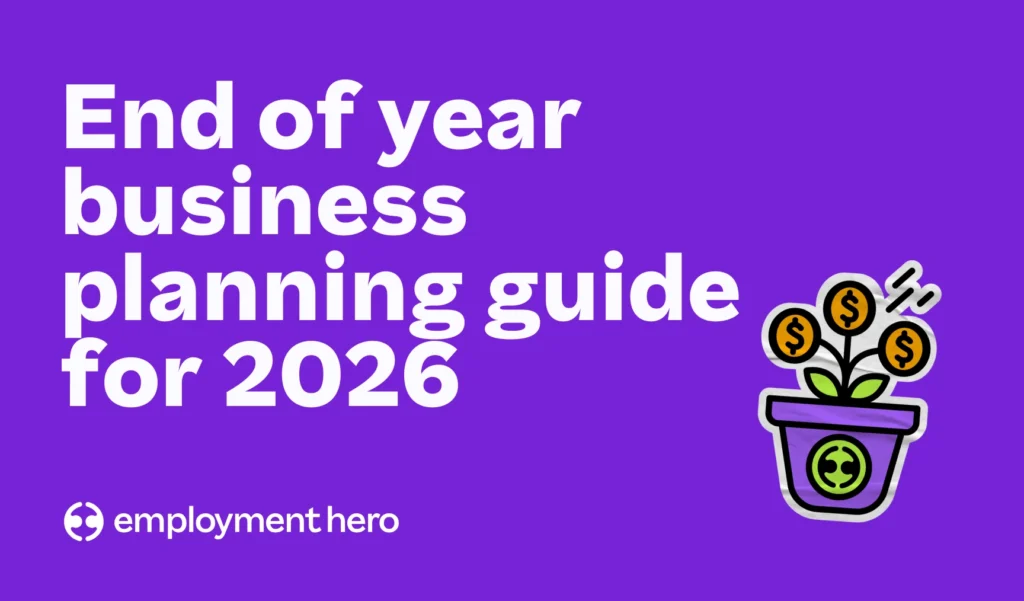End of year business planning guide for 2026

Contents
The end of the year can feel like a mad dash to the finish line. You’re wrapping up projects, managing holiday schedules and trying to find a minute to breathe. It’s tempting to just close the books and hope for the best in January. But the most successful business owners know that what you do in these final weeks sets the stage for the entire year to come.
Year-end is a chance to reset, get real with your numbers and create a launchpad for growth. Whether you’re a seasoned entrepreneur or running your first business, using this time intentionally is your biggest untapped advantage.

Why year-end planning is your secret weapon for a strong start
If you’ve ever felt like you’re just along for the ride in your business, year-end planning is your moment to take the wheel. It’s much more than closing the books and checking off tax to-dos. Smart year-end planning is the single most strategic exercise a business owner can do. It’s your opportunity to step out of the daily scramble, look reality in the eye and ask the tough questions: What worked? What failed? What’s holding us back? Where do we want to go next and what will it take to get there?
Year-end planning is all about turning data into decisions, hindsight into foresight. It’s the fork in the road between businesses that meander through another year and those that attack the new year with focus, facts and a plan that actually matches their ambition. You’ll separate yourself from the pack the moment you stop seeing this as an annoying admin chore and start using it as your strategic edge.
Your ultimate year-end planning checklist
Let’s get down to business. Here’s your no-nonsense, actionable guide for owning your year-end and blasting into 2026 with confidence and control.
1. Get your financial house in order
First things first: chaos in your books is chaos in your business. Clean financials are more than good hygiene—they’re the bedrock of every smart decision you’ll make next year. Start by reconciling every account: bank, credit card and lines of credit. Check for discrepancies, outstanding transactions or mystery charges that have slipped through the cracks.
Hero Tip: Use your banking platform’s auto-reconciliation tools if possible or trusted accounting platforms like Xero or QuickBooks. If you’re dealing with a mountain of paperwork, consider bringing in extra help for a one-off “financial deep clean.”
Now, take a moment to review your invoicing. Are old accounts receivable clogging up your cash flow? Send friendly (but firm) reminders or settle overdue bills. This isn’t just about making your accountant happy—it’s about giving yourself a crystal-clear picture of what you have to work with.
2. Put your financial reports under the microscope
Once your numbers are in order, dig deep. Don’t just glance at the Profit & Loss statement—scrutinize it. Explore every line on your Balance Sheet. Track the movement in your Cash Flow Statement.
- Is revenue up, but profits suspiciously flat?
- Are inventory levels bloated?
- Where are you consistently overspending?
- Have you built up a tax liability you weren’t expecting?
Lean into the discomfort of what these reports reveal. Too often, Canadian business owners put this off out of fear or overwhelm. But facing the hard numbers now is what separates the reactive from the truly strategic. If something doesn’t add up, figure out why—then fix it before the new year.
3. Master your cash flow
You’ve probably heard it before, but it bears repeating: profit is nice, but cash pays the bills. Walk through your cash flow for the last 12 months. Plot the peaks and valleys. Notice any seasonal troughs or months where cash felt tight?
Don’t stop there. Dive into accounts receivable and payable. Who are your best and worst payers? Are you letting invoices age out past 30 or 60 days? Set payment reminders, consider introducing incentives for early payment or even tightening up credit terms for repeat offenders.
Forecast your cash flow into the new year based on known income and expenses. Will you hit a shortfall at any point? Knowing this now gives you time to plan—whether it’s to stash away a buffer, negotiate a line of credit or adjust your spending.
4. Make your year-end tax strategy work for you
Canada’s tax system rewards strategic, forward-thinking business owners. Proactive planning at year-end can help reduce your tax bill and prevent headaches.
- Major purchases: Planning to buy new equipment? Purchase it before year-end to maximize your Capital Cost Allowance (CCA) deduction.
- Employee bonuses: If you’re rewarding your team, process year-end bonuses in December so they’re deductible this year.
- Payroll remittances: Double-check all remittances to the CRA are up to date. Late or missing payments mean interest and penalties.
- Expense reviews: Don’t forget home office expenses, vehicle use, charitable donations and other deductions that can ease your tax burden.
Set up a call with your accountant before December wraps. Test your assumptions and make sure you’re not missing out on tax-saving opportunities unique to your industry or province.
5. Confront the reality of your goals
It’s time for radical honesty. Dig out your goals and budgets from last year. Which targets did you hit and which ones did you miss by a mile? Don’t sugarcoat it—this reflection is where the gold lies.
For every target, ask: Why did we (not) achieve this? Was it lack of time, resources, skill or something external (like market shifts or new regulations)? If you crushed a goal, capture the lessons. If you missed the mark, identify what you’d do differently. Turn regret into a powerful learning tool.
Hold a team debrief to gather wider perspective. Sometimes your frontline staff will have insight into missed targets (or surprise wins) that you would otherwise miss.
6. Identify what’s broken and fix it
Year-end is the best time to look your business in the eye and ask, “What’s just not working?” Ruthlessly audit your operations. Maybe it’s that money-pit marketing campaign with zero ROI or a workflow that’s slowing everyone down.
Don’t keep throwing good money after bad. Cut what’s not serving you—whether it’s a product, service or even an outdated policy. Reinvest those resources where they’ll make a difference and elevate what’s already winning.
This process is easier with honest, open feedback from your team. Invite input and be ready to make tough calls.

7. Review your greatest asset: your people
Your team is your biggest investment—and often your biggest variable expense. Year-end is the time to review your org chart, team performance, pay rates and skill gaps.
- Who went above and beyond? Are you rewarding them to retain them?
- Are your compensation packages still market competitive given inflation and sector trends?
- Do you have the right people in the right roles?
- Where do you need to hire, train or promote to reach next year’s goals?
Don’t shy away from tough conversations. An honest, people-focused review now can prevent bigger headaches (and unnecessary turnover) down the road.
Pro tip: Use an HR platform like Employment Hero to automate performance reviews, gather feedback and benchmark salaries in real time.
8. Set goals that inspire action, not just fill a spreadsheet
Forget the vague “increase sales” goals. Instead, set bold, actionable and measurable objectives for 2026. Use the Objectives and Key Results (OKRs) framework:
- Objective: What’s the big, exciting goal? (e.g., “Expand into the Toronto market.”)
- Key results: What are the numbers that will prove you did it? (e.g., “Sign 30 new clients in Toronto by June.”)
Share these goals across your business. Everyone should know what winning looks like. Track progress openly and make adjustments as you go—the goal is alignment, not bureaucracy.
9. Build a budget that fuels your ambition
Your budget is your strategy in numbers. Don’t just roll over last year’s figures. Build next year’s budget from the ground up, based on your new goals, actual performance and the market realities you’ve just uncovered.
- Forecast your income conservatively but ambitiously.
- Map out fixed and variable expenses. Don’t forget new technology, training or marketing investments.
- Make room for risk: set aside a contingency fund for the unexpected.
Monitor your budget monthly, not just at year-end. This way, you can spot variances early and course-correct before small issues become big problems.
The year-end payroll wrap-up: A Canadian employer’s duty
Payroll is non-negotiable, and year-end brings its own list of critical tasks for Canadian employers. Failing to get this right isn’t just a hassle—it can mean fines and unhappy employees, too.
- Final payroll run: Process the last payroll of the calendar year. Include any owed overtime, commissions or vacation payouts.
- Year-end bonuses: If you’re rewarding your team, these need to be paid and remitted before December 31st if you want the deduction this year.
- Reconcile payroll accounts: Make sure every deduction and contribution (CPP, EI, provincial taxes) is accurately matched up. Chase down any gaps or overpayments.
- T4 and T4A slips: Start preparing these now, not at the last minute, so employees get them by the CRA deadline (end of February).
Doing this manually? You’re playing with fire. Even a small error can snowball into a CRA nightmare. This is exactly where tools like Employment Hero shine – taking the pain out of year-end payroll,automating calculations and flagging any issues before they become problems. Instead of drowning in paperwork and compliance stress, you get to hit “approve” and focus on celebrating with your team.
How to review your tech stack and vendor contracts
Year-end is the golden opportunity to clean house on your technology and vendor relationships. Many Canadian businesses stick with outdated systems because “that’s just how we’ve always done it.” Sound familiar?
Audit every subscription, software and service you use. Ask:
- Are we using this tool to its full potential or is it collecting dust?
- Could we consolidate systems for better integration and less double-entry?
- Are we getting responsive, Canadian-based support when we need it?
- Is there better ROI to be found, either by switching or renegotiating terms before contracts renew?
Modern HR and payroll platforms like Employment Hero replace a patchwork of outdated tools with a single, integrated system—cutting out inefficiencies and saving you real dollars each month. With automated reporting, seamless compliance updates and an intuitive dashboard, it turns technology from a headache into a superpower.
Ready to explore how Employment Hero could supercharge your HR and payroll processes in 2026?
Plug into performance: Employment Hero for year-end and beyond
Let’s get real—none of this year-end stuff is easy if you’re lost in spreadsheets and paper files. Employment Hero was built for busy Canadian businesses who want to get payroll, people management and compliance right—without losing sleep or wasting time.
- Year-end payroll, simplified: Automate the final pay run, generate your CRA slips and reconcile in minutes—not hours.
- All-in-one HR management: From performance reviews and onboarding to time-off tracking and reporting, manage your team with less admin and more impact.
- Strategic support: Our analytics and reporting help you spot trends, track your goals and make smarter, data-driven business decisions year-round.
- Continuous compliance: We stay on top of employment legislation updates (federal and provincial) so you don’t have to, keeping your business safe and nimble.
Thousands of Canadian companies have already traded clunky systems and compliance stress for control, confidence and a stronger team. Why not join them?
Make next year your best yet
Year-end isn’t just about closing out a year—it’s your ticket to launching the next one with momentum and clarity. Take the time to reflect, audit and act now. Use your numbers as truth-tellers. Lean on the right tools and partners to automate the noise and free up your brain for big-picture strategy.
The businesses that win tomorrow are planning today. You’ve got the tools, the guide and now the know-how. Ready to close 2026 with confidence and surge into the new year? Employment Hero has your back—every pay run, every goal, every step of the way.
Related Resources
-
 Read more: 2025 federal budget: What Canadian employers need to know
Read more: 2025 federal budget: What Canadian employers need to know2025 federal budget: What Canadian employers need to know
Discover what Canada’s 2025 federal budget means for employers, from enhanced SR&ED incentives to new talent and funding opportunities.
-
 Read more: What tech founders should know about the 2025 federal budget and why this year is the perfect time to double down on SR&ED
Read more: What tech founders should know about the 2025 federal budget and why this year is the perfect time to double down on SR&EDWhat tech founders should know about the 2025 federal budget and why this year is the perfect time to double down on SR&ED
Discover how the 2025 federal budget enhances SR&ED for Canadian startups. Learn how founders can maximize refunds, extend runway and…
-
 Read more: Best time and attendance software in Canada (2026)
Read more: Best time and attendance software in Canada (2026)Best time and attendance software in Canada (2026)
Looking for the best time and attendance software in Canada? We compare top HR platforms to help you find the…


















